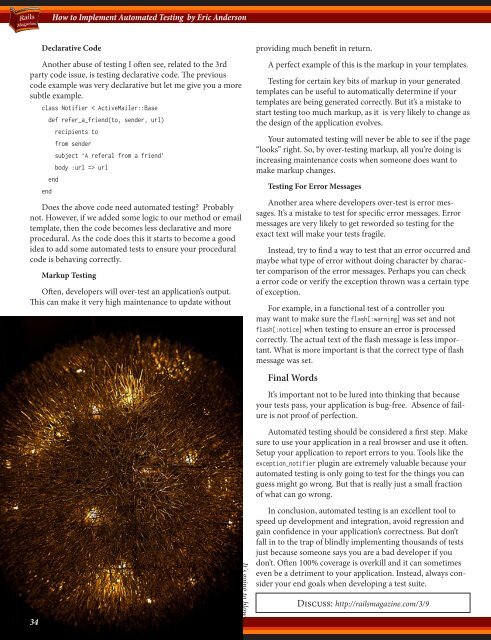Rails Magazine - Issue 3
Rails Magazine - Issue 3
Rails Magazine - Issue 3
Create successful ePaper yourself
Turn your PDF publications into a flip-book with our unique Google optimized e-Paper software.
34<br />
How to Implement Automated Testing by Eric Anderson<br />
34<br />
Declarative Code<br />
Another abuse of testing I often see, related to the 3rd<br />
party code issue, is testing declarative code. The previous<br />
code example was very declarative but let me give you a more<br />
subtle example.<br />
class Notifier < ActiveMailer::Base<br />
def refer_a_friend(to, sender, url)<br />
recipients to<br />
from sender<br />
subject ‘A referal from a friend’<br />
body :url => url<br />
end<br />
end<br />
Does the above code need automated testing? Probably<br />
not. However, if we added some logic to our method or email<br />
template, then the code becomes less declarative and more<br />
procedural. As the code does this it starts to become a good<br />
idea to add some automated tests to ensure your procedural<br />
code is behaving correctly.<br />
Markup Testing<br />
Often, developers will over-test an application’s output.<br />
This can make it very high maintenance to update without<br />
It's going to blow<br />
providing much benefit in return.<br />
A perfect example of this is the markup in your templates.<br />
Testing for certain key bits of markup in your generated<br />
templates can be useful to automatically determine if your<br />
templates are being generated correctly. But it’s a mistake to<br />
start testing too much markup, as it is very likely to change as<br />
the design of the application evolves.<br />
Your automated testing will never be able to see if the page<br />
“looks” right. So, by over-testing markup, all you’re doing is<br />
increasing maintenance costs when someone does want to<br />
make markup changes.<br />
Testing For Error Messages<br />
Another area where developers over-test is error messages.<br />
It’s a mistake to test for specific error messages. Error<br />
messages are very likely to get reworded so testing for the<br />
exact text will make your tests fragile.<br />
Instead, try to find a way to test that an error occurred and<br />
maybe what type of error without doing character by character<br />
comparison of the error messages. Perhaps you can check<br />
a error code or verify the exception thrown was a certain type<br />
of exception.<br />
For example, in a functional test of a controller you<br />
may want to make sure the flash[:warning] was set and not<br />
flash[:notice] when testing to ensure an error is processed<br />
correctly. The actual text of the flash message is less important.<br />
What is more important is that the correct type of flash<br />
message was set.<br />
Final Words<br />
It’s important not to be lured into thinking that because<br />
your tests pass, your application is bug-free. Absence of failure<br />
is not proof of perfection.<br />
Automated testing should be considered a first step. Make<br />
sure to use your application in a real browser and use it often.<br />
Setup your application to report errors to you. Tools like the<br />
exception_notifier plugin are extremely valuable because your<br />
automated testing is only going to test for the things you can<br />
guess might go wrong. But that is really just a small fraction<br />
of what can go wrong.<br />
In conclusion, automated testing is an excellent tool to<br />
speed up development and integration, avoid regression and<br />
gain confidence in your application’s correctness. But don’t<br />
fall in to the trap of blindly implementing thousands of tests<br />
just because someone says you are a bad developer if you<br />
don’t. Often 100% coverage is overkill and it can sometimes<br />
even be a detriment to your application. Instead, always consider<br />
your end goals when developing a test suite.<br />
Discuss: http://railsmagazine.com/3/9


